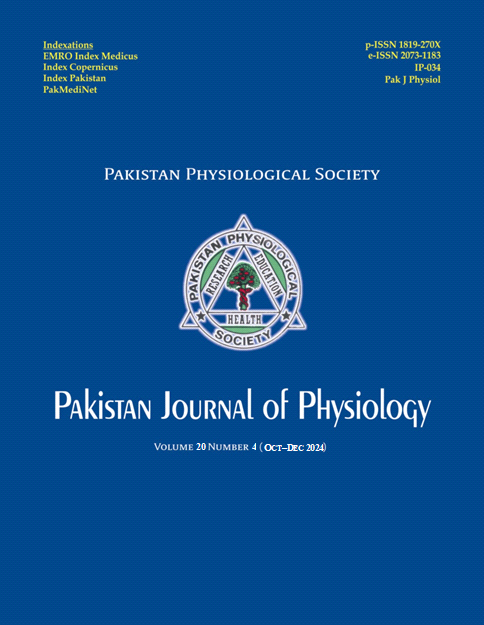HISTOPATHOLOGICAL DIAGNOSIS OF PLEURAL BIOPSIES RECEIVED AT A TERTIARY CARE CENTRE
DOI:
https://doi.org/10.69656/pjp.v20i4.1712Keywords:
pleural biopsies, empyema thoracis, tuberculosis, pleurisyAbstract
Background: Pleural diseases are common, affecting a significant number of patients worldwide. Pleura are frequently involved secondary to diseases like pneumonia, cardiac failure and pulmonary tuberculosis, whereas primary pathological diseases of the pleura are exclusively uncommon. In majority of the cases diagnosis can be made by history, clinical examination, laboratory tests and imaging studies. Biopsy is however required for definitive diagnosis of certain infective conditions and all neoplastic lesions as in some cases, the management is prolonged and expensive as well. This study highlights the role of biopsies in diagnosis of uncommon pleural pathologies. Methods: All pleural biopsies received at the Pathology Department of Ayub Medical College, Abbottabad from Jan 2014 to Dec 2023 were included in the study. Haematoxylin and Eosin (H & E) stained slides were examined to determine the frequency of various pathological lesions affecting pleura. Special stains and immunohistochemistry were performed whenever required. Results: A total of 222 biopsies were included in this study. The most common pathology in pleural biopsies was chronic non-specific pleuritis constituting 86 (38.7%), followed by empyema in 85 (38.3%) cases. Chronic granulomatous inflammation due to tuberculosis was seen in 20 (9%) cases. Rare infections like actinomycosis and fungal infection were identified in 2 cases. Conclusion: In this study the most common pathology identified on pleural biopsy was chronic non-specific pleuritis, while one case each of actinomycosis and fungal infection were seen.
Pak J Physiol 2024;20(4):48-51, DOI: https://doi.org/10.69656/pjp.v20i4.1712
Downloads
References
Bodtger U, Hallifax RJ. Epidemiology: why is pleural disease becoming more common? In: Maskell NA, Laursen CB, Lee YCG, Najib MR. (Eds). Pleural Disease (ERS Monograph). Sheffield, European Respiratory Society, 2020; p.1–12.
Charalampidis C, Youroukou A, Lazaridis G, Baka S, Mpoukovinas I, Karavasilis V, et al. Pleura space anatomy. J Thorac Dis 2015;7 (Suppl 1):S27–32.
Kass SM, Williams PM, Reamy BV. Pleurisy. Am Fam Physician 2007;75(9):1357–64.
Karpathiou G, Stefanou D, Froudarakis ME. Pleural neoplastic pathology. Respir Med 2015;109(8):931–43.
Gupta I, Eid SM, Gillaspie EA, Broderick S, Shafiq M. Epidemiologic trends in pleural infection. A nationwide analysis. Ann Am Thorac Soc 2021;18(3):452–9.
Maldonado F, Lentz RJ, Light RW. Diagnostic approach to pleural diseases: new tricks for an old trade. F1000Research 2017;6:1135.
Chinchkar NJ, Talwar D, Jain SK. A stepwise approach to the etiologic diagnosis of pleural effusion in respiratory intensive care unit and short-term evaluation of treatment. Lung India 2015;32(2):107–15.
Sundaralingam A, Bedawi EO, Rahman NM. Diagnostics in pleural disease. Diagnostics (Basel) 2020;10(12):1046.
Addala DN, Denniston P, Sundaralingam A, Rahman NM. Optimal diagnostic strategies for pleural diseases and identifying high-risk patients. Expert Rev of Respir Med 2023;17(1):15–26.
Memon JH, Sadiq S. Morphological study of pathological lesions seen in pleural biopsies. Pak J Med Sci 2010;26(3):673–7.
Bhatnagar R, Maskell N. Developing a ‘pleural team’ to run a reactive pleural service. Clin Med (Lond) 2013;13(5):452–6.
Porcel JM, Light RW. Pleural effusions. Dis Mon 2013;59(2):29–57.
Karpathiou G, Hathroubi S, Patoir A, Tiffet O, Casteillo F, Brun C, et al. Non-specific pleuritis: pathological patterns in benign pleuritis. Pathology 2019;51(4):405–11.
Kim NJ, Hong SC, Kim JO, Suhr JW, Kim SY, Ro HK. Etiologic considerations of nonspecific pleuritis. Korean J Intern Med 1991;6(2):58–63.
Kapp C, Janssen J, Maldonado F, Yarmus L. Nonspecific pleuritis. In: Maskell NA, Laursen CB, Lee YCG, Najib MR. (Eds). Pleural Disease (ERS Monograph). Sheffield: European Respiratory Society; 2020.p. 211–7.
Saleem AF, Shaikh AS, Khan RS, Khan F, Faruque AV, Khan MM. Empyema thoracis in children: clinical presentation, management and complications. J Coll Physicians Surg Pak 2014;24(8):573–6.
Khan MA, Bilal W, Asim H, Rahmat ZS, Essar MY, Ahmad S. MDR-TB in Pakistan: Challenges, efforts, and recommendations. Ann Med Surg (Lond) 2022;79:104009.
Ruan SY, Chuang YC, Wang JY, Lin JW, Chien JY, Huang CT, et al. Revisiting tuberculous pleurisy: pleural fluid characteristics and diagnostic yield of mycobacterial culture in an endemic area. Thorax 2012;67(9):822–7.
Kim SR, Jung LY, Oh IJ. Kim YC, Shin KC, Lee MK, et al. Pulmonary actinomycosis during the first decade of 21st century: cases of 94 patients. BMC Infect Dis 2013;13:216.
Panou V, Bhatnagar R, Rahman N, Christensen TD, Pietersen PI, Arshad A, et al. Advances in the diagnosis and follow-up of pleural lesions: a scoping review. Expert Rev Respir Med 2024;18(6):423–34.
Chan C, Chan KKP. Pleural fluid biomarkers: a narrative review. J Thorac Dis 2024;16(7):4764–71.
Downloads
Published
How to Cite
Issue
Section
License
Copyright (c) 2024 Anila Riyaz, Fouzia Jehangir, Shabana Malik, Sabahat Asghar, Maria Akhtar, Abid Ali Khawaj

This work is licensed under a Creative Commons Attribution-NoDerivatives 4.0 International License.
The author(s) retain the copyrights and allow their publication in Pakistan Journal of Physiology, Pak J Physiol, PJP to be FREE for research and academic purposes. It can be downloaded and stored, printed, presented, projected, cited and quoted with full reference of, and acknowledgement to the author(s) and the PJP. The contents are published with an international CC-BY-ND-4.0 License.












